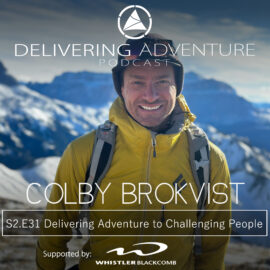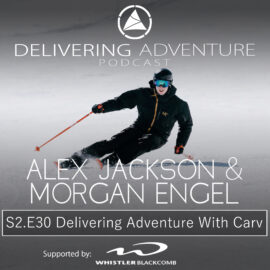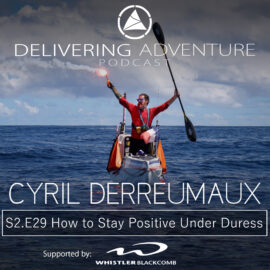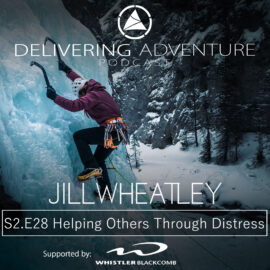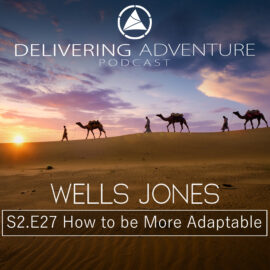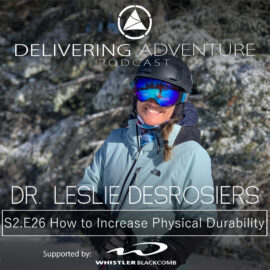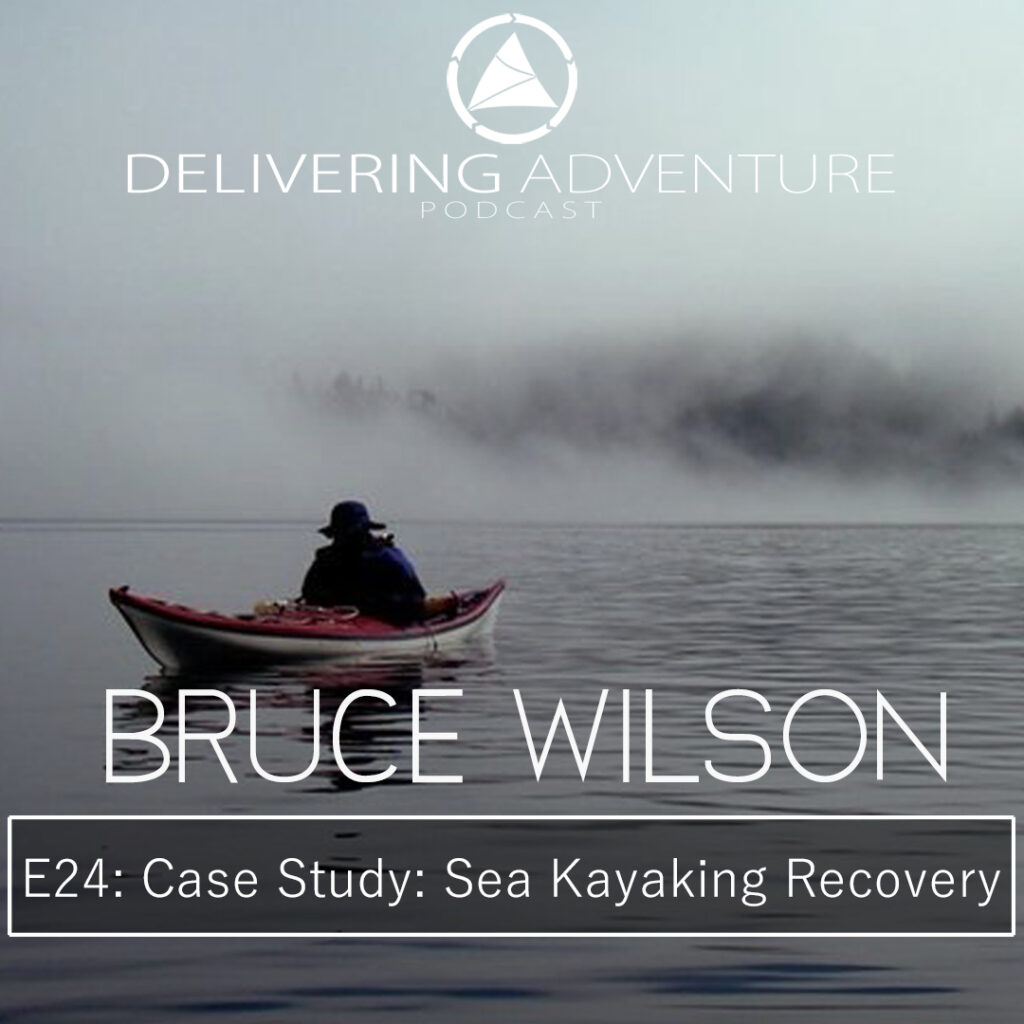
Case Study: Sea Kayaking Recovery with Bruce Wilson
The line between an adventure and a misadventure is often defined by our decisions, how we manage the challenges that we face and how the experience is remembered afterwards. In this episode, Bruce Wilson returns to share a story that seriously tested his skills to deliver adventure. This is a story from early in his sea kayak guiding career. Afterward, Chris and Jordy share their insights into the lessons that we can all learn from Bruce’s experience and how he ultimately turned what could have been a disaster into an exciting adventure for his clients.
Key takeaways:
Human factors can compromise judgement: These factors include bias, blindness and a lack of foresight.
Pressure to deliver: Every guide can succumb to the pressure to deliver an amazing adventure, even when they have concerns about about the wisdom of doing so.
Letting people suffer to convince them: Sometimes, a leader has to expose people to a small measure of the adversity they are going to face, so they can understand why following a course of action is not in their best interest.
Practice failure: Spending time to practice rescue, recovery and reactions skills effectively, can save time and stress in a moment of crisis.
Debrief: Taking time to talk about challenging and traumatic experiences can be the difference between whether a situation is remembered as an adventure or a misadventure.
Guest Links
You can contact Bruce through Wolf Warrior Guide Services: https://warriorwolfguide.com/
Follow or Subscribe
Enjoyed this episode? Please follow or subscribe. Thanks!
Share & Social Links
https://linktr.ee/deliveringadventure
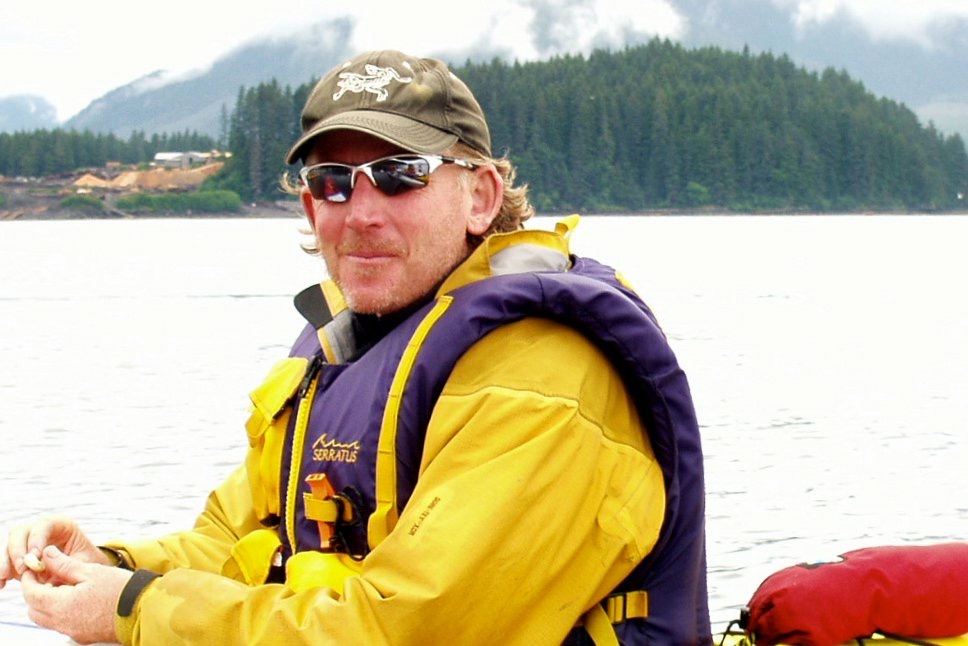
Episode Transcript
[00:00:00] Bruce Wilson: It’s mayhem out there. It’s like waves, breaking waves, big waves, and it’s definitely not somewhere I want to be. The two cocks go by me and the double cock goes by me, and so they’re out in the mayhem. I don’t know why anybody would make that decision, but they’ve made that decision. And so, I had stopped at that point and just looked back at my assistant guys and looked at his eyes, which were about the size of dinner place.
[00:00:30] Chris Kaipio: Welcome to Delivering Adventure. This is the podcast that explores what it really takes to share adventure like a pro with your friends, your family, and as a profession. My name is Chris Kaipio, and I’m coming to you from Whistler, British Columbia.
[00:00:48] Jordy Shepherd: And I’m Jordy Shepherd, recording from Canmore, Alberta.
After a lifetime of working extensively in different parts of the adventure guiding industry, Chris and I have teamed up to launch this podcast. In each episode, you’ll hear top adventure guides, managers, marketers, and athletes share their best stories, advice, and trade secrets. The goal of this podcast is to share how you can take yourself and others farther from the mountains to the office and.
[00:01:17] Chris Kaipio: In this episode, we’re going to do something a little bit different. We’re going to share the first of what we hope will be many stories that we are going to use as case studies. The point of sharing these case studies will be to highlight key lessons from real life situations that have happened to real adventure pros.
The story that we are going to share with you in this episode comes from Bruce Wilson. And I just want to say, while this involves a sea kayaking incident, the lessons we’re going to explore apply to any activity and many aspects of our lives.
[00:01:52] Jordy Shepherd: If you missed episode 14, Bruce Wilson is an ACMG. That’s Association of Canadian Mountain Guides Hiking Guide, a Sea kayaking guide, and a guide trainer With the Association of Canadian Sea Kayak Guides, a Canadian Avalanche Association, avalanche Professional.
An instructor for Caplan University’s outdoor recreation management program and a Vision Quest instructor. Bruce has a master’s degree in leadership, as if that wasn’t enough for credentials. Bruce also owns and operates Warrior Wolf Guide Services and coaching. The story that Bruce shares with us came early in his sea kayak guiding career.
[00:02:29] Chris Kaipio: Okay, let’s hear Bruce share what I am sure was the most stressful moment of his guiding career.
[00:02:37] Bruce Wilson: Let me just paint the picture here for you. So it was early on in my guiding career and uh, I think probably actually the first year I was professionally guiding and, uh, I was leading an eight day trip off the west coast of Vancouver Island, and you’re not familiar with the geography of British Columbia.
There’s the mainland and then the straight of Georgia, then there’s Vancouver Island. So I was on the, the west side of Vancouver Island. Which then next stops essentially is Japan. So, there’s a lot of ocean on that west side in terms of exposure. And I was actually on some outer islands west of Vancouver Island, so I was leading an eight day trip out there.
And uh, I was reflecting on it afterwards actually, and I was thinking about this as far as what happened. Detail that had escaped me originally was I actually had done this trip a few weeks before and I was totally successful. So I think what that actually did in my mind is it set me up in that confirmation bias.
Unbeknownst to me in that I’ve done this before, so the programming was already starting to. Occur in my head that, oh yeah, it’ll just work out the same way again. It didn’t. So essentially what we did is we left from this little town called Tofino, and we paddled out on our eight-day trip, and this was about, uh, Day three, I think it was.
And I had a full group, which meant that there were eight people, eight participants, and I was with a, an assistant guide as well. So there, there were the two of us. And when we got to this location, we’re on a, a smaller outer island from Vancouver Island on the west side. So that means that, you know, the full brunt of the ocean relative to water, wind, exposure, waves, everything was right there.
That was our neighbor and. I pulled us into this little campsite, this little beach, which was really nicely situated with freshwater and protected. But, uh, when we got there, what happened is that, uh, basically we got hunkered in, like the weather moved in, so we were stuck. So, we’re stuck on this little beach.
And, uh, some of these people, you know, were, we’re pretty driven individuals. I would say, you know, typically the, the demographic of somebody who can pay for, you know, a professional guided. You know, they’re, they’re accomplished in life. So we essentially spent, uh, you know, one day beach bound and, uh, that was cool.
You know, people relaxed and chilled and, you know, just enjoyed being in that space. And then, uh, day two came around, you know, day two of being on that beach at least. And, uh, the weather was still, you know, pretty socked in and pretty windy and, uh, wavy, we still couldn’t go anywhere. And so, the other thing, you know, often with these types of people as well, they’re not really, uh, tuned into the environment so much.
You know, it’s like we know relative to when we’re out there, what’s, what’s a go, what’s a no. And so there was this momentum that was starting to build behind me, and the momentum was from the group there was starting to push me in terms of, well, we didn’t pay to sit on a beach. We actually paid to be in our kayaks traveling and moving from location to location.
So, , what are we doing sitting on this beach? And so I was feeling a lot of pressure and I was having conversations with my, my co-guide and he was saying, oh no, totally. We’re doing the right thing for sure, sitting on this beach. And so that day now passes and then another day approaches. And I was listening to the weather radio and it said, you know, there, there, there probably is a.
And so prior to this, we’d had some big weather conditions offshore. So like some really big weather conditions like, you know, 30 knot, 40 knot winds way offshore. And the one thing you need to understand as well is that with the ocean and a wave, you know, as soon as that, Wind builds energy into that wave.
It starts building in size and momentum, and it doesn’t release that energy until it either comes up against something like a shoreline or the water gets shallower. So, like I said, I was, early on in my career, I wasn’t completely dialed in, I’m sure with all the, the nuances of all of this. So I thought, okay, so we’ve got this weather window, so it’s calm right now.
So what we’ll do, and there’s a lot of pressure from the group, a lot of. We’ll break camp and we’ll go for it. And so I was still also fixated on the agenda in terms of the itinerary that this was the itineraries that were going to go further up the coast on the outer side. That’s what these people had paid for.
So, we packed up, loaded up, and uh, we all got into our kayaks. And as we’re paddling, we’re actually on the lee side or the opposite side. The direct ocean, because there’s a reef and a reef line that’s, uh, basically created this pocket where we’re paddling through. So, it’s relatively protected, relatively calm.
We’re paddling along and I’m thinking, you know, oh yeah, cool. It’s like, yeah, this is, this is good. I can do this. And, uh, so we’re paddling along, and in that group, there were two double kayaks and four single kayaks. And myself and the other guide were in single Kay. and we’re paddling along, and then we’re getting towards the end of the reef in terms of the protection.
And uh, when we get to the very end there of the reef, I’m starting to paddle out and then I look out on my left side, which is the west side, out towards the ocean. It’s just like, holy shit. I’m sorry. It’s like, it’s mayhem out there. It’s like, Waves, breaking waves, big waves, and it’s definitely not somewhere I want to be.
So, as I’m paddling, I turn my head and shout back to the group. Stop. I put my paddle up to stop everybody. However, the momentum, some of these people are already right behind me. Two guys were right behind me plus one of the double kayaks. So, I say stop, and I’m back LA back paddling to stop. The two cocks go by me and the double kay goes by me.
And so, they’re out in the mayhem. I don’t know why anybody would make that decision, but they made that decision. And so, I had stopped at that point and just looked back at my assistant guys and looked at his eyes, which were about the size of dinner plates, and he’s going, we do not want to be out there.
And I’m going, yeah, you got it. So when I turn back from looking at him, because he’s captured the rest of the group, so he’s captured that other double and the two singles and they’re all rafted up together. And uh, so I turn and look back out and what do I see while I see two halls, so two cocks that are upside down and then I see the double out there, right side up.
So immediately, you know, I want to get those people outta the water. And so I paddle, you know, just full adrenaline charge to the one kayak. And, uh, you know, it’s, there’s two older gentlemen and the way it turned out is the two old guys in the ocean, unfortunately, the two old skinny guys who were gonna get cold pretty quick.
So anyhow, I got the one guy back into his kayak pretty quick and uh, basically just had him stay really close to me, told the, the double cock to. Put where they were. Then I went to get to the other guy and get him back into his kayak. And then when I got his kayak upright and he was by the kayak, I noticed there was a huge chunk sort of cut in the.
In the kayak and basically what had happened is that the double had surfed backwards and T-bone. This guy with its rudder cut his kayak, you know, almost in half. And the only thing that stopped it from getting cut in half was actually his, his thigh on his leg. So he had this terrible gouge or cut I guess, or laceration in his leg.
So he is pumping a little water, or sorry, he blood into the water as. And I was just envisioning the, the fins starting to pop up and start to circle, but fortunately that wasn’t happening at that point in time. And, uh, got him back in his kayak as well. And so, these two guys were cold. Like they were cold.
And this one guy was in shock for sure. And so, the double kayak and I look back out to see where that is. It’s gone. I can’t see it because what’s happened now is that we’ve got this mayhem as far as the water, but we’ve also got sea fog rolling in. So it’s just like somebody’s pulled a blanket over the whole situation and it’s just lights out.
And so I think, shit, I gotta make a decision. I gotta make a decision. And the decision is, I’ve got two guys for sure. I’ve got an unknown in that double kayak that’s just offshore. I don’t, I don’t know where they are anymore, but I just gotta make the hard call. You know, I’m. I gotta take care of these two guys.
So, I take the two guys and we get back in behind the reef there. And uh, the guy I was working with, the assistant, he was already on the beach and had a fire started and, you know, got these two guys through shore and uh, basically got them set up and the rest of the group was fine. And, uh, got everybody looked after and then now I’ve gotta go back out to find this elusive double kay.
And so the whole time when I’m out there now, I’m, I’m paddling along to go to the end of the reef and I get to the end of the reef, you know, SO’S take two. And I look out there and it’s just like, it, it’s not where I want to go. It’s like everything in me is saying I do not want to be out there. And so it was like at that moment in time, it was just like, You know, just gripping my teeth and my jaw shut because if I hadn’t, it was just going to be the scream that was going to be released outta my mouth.
In terms of, well, you can imagine the words I was probably going to use and, uh, just trying to get a grip, you know, just trying to get a grip on myself and so, I realized that, well, I’m here, you know, so I got to take acceptance of that for being in this situation. I also have to take responsibility for too.
It’s like I put myself in this situation and these other people as well, so, A little bit of breathing and, uh, you know, basically said, okay, gonna do this. And, uh, paddled out, paddled out through these breaking worry waves and this sort of, you know, messy, nasty sea state and little bit of reef and rocks and stuff around.
I just keep paddling out into the fog and I paddled in the fog for probably, it felt like a, a lifetime for sure. I’m sure it was a couple of lifetimes. And, uh, eventually actually popped out of the. and uh, when I popped outta the fog, it was beautiful blue sunshine and there they were, the two ladies in the double cock, just bobbing around out there and happy as could be, I think, you know, but happy to, to see me for sure as I was very happy to see them.
And I paddled out to them and, uh, the first thing they said to me was, we knew you’d be back. And it was like myself be, I’m glad you’re certain, because I wasn’t so sure at one point in that I didn’t want to make, but I said based on the fact that I provided an agenda, an itinerary as getting paid by these people, they’re obviously not that happy with, you know, the weather.
But instead of having, you know, the understanding of that point in time of just saying, well, it’s just the weather, it’s just the way it is. I was taking it very personally in terms of, well, it’s me that’s not delivering the product or the service. So that was a big takeaway for me. And the other takeaway was to.
The importance of really clear and effective communication. So, you know, they got by me because I didn’t put enough energy into that. Stop breaking that momentum at that moment in time relative to the situation. You know, I dialed it up for sure, but it wasn’t a hundred percent dialed up in terms of stop here now.
It was. More of a, whoa, I’m overwhelmed. And now my message that’s coming back is somewhat diluted because, you know, I was overwhelmed in terms of not just, you know, the amount of information that was coming at me in terms of physical environment that I was just, you know, everything was saying You do not want to be here, but I was already there, and so, Somehow building in a much deeper pause in terms of, you know, instead of just moving through that situation, breaking that situation before entering into it was certainly a big take away as well.
Well the irony of the whole story was that, uh, you know, the same group except for the two ladies showed up the next year and we did the trip and it worked out flawlessly. It was beautiful. Then on the last day of the trip, they all got together on the beach and they said to me, you know, we had a really great trip.
It was a lot of fun, but last year was. And I was like, whoa, , you know, it was more exciting. It was more adventurous. It was just, whoa. That was intense and yeah, it was ironic, but, uh, yeah, they love that.
[00:15:09] Jordy Shepherd: Okay. Chris, what comes to mind when you listen to that story?
[00:15:13] Chris Kaipio: Well, first off, I’m really glad that didn’t happen to me.
Yeah, no kidding. Second, I have to say that it takes a lot to put yourself out there and share stories like this. So, a huge thanks to Bruce for having the humility to share this story with our listeners so that we can all learn from this experience. The fact that he so freely shared this story with our listeners is exactly why I consider Bruce to be a master guide.
There’s a lot to take in from this story, and I’m just going to unpack a couple of things before we get into how Bruce saved this situation. Let’s start with reviewing the factors that led up to the moment when things really got difficult. So Bruce has actually shared this story a couple of times with me now.
Once for my book, the Power to Influence and twice for this Podcast in each telling, the key takeaway for me has been just how easy human factors can compromise even the most capable person’s ability to make a good decision. When I say human factors, I’m thinking of what I refer to as the big three, bias, blindness and a lack of fore.
Bias is something that can cause us to prioritize a lesser option over a better one. Bias factors can include personal preferences, motivation, pressure, fear, any number of cognitive biases and heuristics. Blindness happens when we either ignore or miss information, and a lack of foresight happens when we fail to imagine what the likely outcome of following a course of action can.
Sometimes this happens because we are rushing, we are lazy, or we simply can’t imagine what the outcome is going to be. In this case, the human factor that launched Bruce and his group towards misadventure was actually all three to start with. Bruce felt the pressure to deliver an amazing experience to his guests.
After being beach bound for two days, there was immense pressure from the guests and himself to get out and to deliver the adventure that everyone had imagined themselves having. The bias factor at play here is one that every professional guide feels at one time or another, and that is the expectation to deliver what was promised, which in this case was an amazing kayaking.
This pressure may have blinded Bruce to the fact that even though there was a break in the weather just offshore, there was likely to still be large surf. Of course, this wasn’t the only human factor at play. The group members themselves couldn’t imagine what the surf would be like offshore, as they had likely never experienced that for the.
Even if Bruce had been able to talk them into sitting out another day, they wouldn’t have been able to imagine just how difficult paddling and rough seas would be. The problem that Bruce had was that the group was excited to get going and they had no idea what rough seas looked like. How could they, if they had never experienced them before, if you were leading others and you know better, this is something that you need to.
The third human factor I want to touch on here has to do with exactly why Bruce’s group ignored the instructions to turn around once he realized how rough the sea was beyond the protection of the reef from the perspective of the clients, there were probably a couple of things at play. Excitement, which was likely being fueled by a bit of adrenal.
Getting caught up with what others were doing. This is a bit of group think bias and a lack of experience in those conditions were all likely contributing factors. This lack of experience made them blind to the risks. As I have already mentioned, this is a phenomenon that faces anyone who is leading less experienced people in hazardous situations.
So what could Bruce have done to get a better. Well, there are a couple of possible strategies. First off, if he couldn’t contain his group, he could have suggested that they try heading out so that they could check out the conditions with the understanding that they may not be able to paddle that day.
If conditions offshore were difficult, this would’ve allowed the group to get a glimpse of what the hazard offshore was. It is possible, but not guaranteed that this may have created an opportunity for Bruce to demonstrate to the group why they didn’t want to be there. Sometimes to get people to believe that conditions or situations are more difficult than they think you need to let people suffer a little bit.
The trick to do this is to do it in a way that is safe and doesn’t backfire on you by being too. Another strategy that Bruce could have used, and perhaps he did, was to make sure that he communicated to the group beforehand what would happen if Bruce decided the group needed to turn around. If he saw that the waves were indeed too big.
If there was enough time and space, he could have even practiced getting everyone’s attention and grouping up where it was calm, so that when he needed to get everyone’s attention, they were more prepared and focus. In essence, practicing the escape plan beforehand, should he choose to abort under pressure.
An example I’ve seen of this strategy is where I have gone hell in cat skiing. In this case, it is normal for the guide to have the group stop above the guide. This is something that guide practices right from the start on low consequence situations in. So that should the guys stop right above a cliff, everyone has already been trained to stop above the guide.
To be clear, I don’t know if Bruce touched on this with his group or not, but I did want to take the opportunity to highlight the value of doing so. If you don’t practice these things beforehand, in the heat of the moment, people’s instincts can take. In this case, the pressure to get going likely pushed Bruce’s group forward into turbulent waves that were clearly beyond the abilities of some of the group.
So, Jordy, what stuck out to you?
[00:21:49] Jordy Shepherd: Those are all good points. Chris, I agree with your comment about guides feeling pressure to deliver the best experience possible. This is something I think we’ve all felt. Well, it’s easy to say that the rational thing to do is to not go when the conditions are tough or hazardous in the heat of the moment, that can be a hard to do, and depending on your trip, you might have to actually make it through, uh, for the most part, on, on some of these, uh, difficult cruxes, especially when you only have one chance at something.
One way I tackle this is by looking at the potential consequences of going and the consequences of delaying or of turning. Also look at all options, including taking a different route if possible, and even the option of calling someone to transport you around the area of concern, if that is a possibility.
Once you’ve looked at all the potential options and consider writing them down, you can discuss these options with the group provided. There is time for that. I will also often present my recommended course of action. Along with this, the group can then have input and be able to air any concerns they have.
But then in, in the end, a decision needs to be made. If everything is happening quickly without any discretionary time, then you as a leader need to make the decision as Grant Statham discussed in episode 18. Use facts to help you make a decision to go forward and use intuition as a tool to help you make a decision to delay.
Turn around, or, if possible, avoid exposing yourself in the group to the hazard. After decades of guiding multiple sports, I doubt Bruce would’ve made that decision. Now, this is, this occurred early on in his career. This is the benefit of being able to learn from experience and really, this is a great case study and there were good outcomes.
In the end, we’re bringing you the stories so that hopefully you can learn from Bruce’s experience. As I like to say, the best mistake to learn from is someone else’s. So what I would like to do now is look at what Bruce did. And there were quite a few things worth highlighting here. So Bruce did resist course correction bias by turning around.
He recognized the situation was unsafe and took steps to backtrack. Course correction bias happens when we double down on a decision that is clearly flawed. This can happen because of stubbornness pride or belief that something will change or break in our. Bruce was decisive, even though he was probably thinking to himself, why is this happening to me?
He did deal with the main problem first. He prioritized safety of the most vulnerable people first, and this was the people in the water and the guest who was injured by the kayak that ran over his boat instead of worrying about the double kayak that was last seen paddling away, but upright. Another thing that Bruce did well relates to practicing failure as part of professional practice and, and, uh, being prepared and trained.
This highlights why it’s so important to practice failure. In this case, Bruce’s ability to do a quick rescue and rough seas and to do first aid under pressure. Were really quite tested and this is why it is so important to practice these skills beforehand and have them dialed and have your equipment ready to go.
Bruce also showed really strong leader. He demonstrated great leadership by getting everyone back to the beach safely and quickly as totally as fast as possible in the safest way possible, Bruce did stay calm and focused, which is critical for any leader to do, especially in a difficult situation like this.
While Bruce felt the pressure to deliver an amazing experience to his guests, he wasn’t pressured to leave his group members on the beach and to head out looking for the missing kayakers before he knew they were. Instead, he did first aid, built a fire to warm up the cold kayakers who had capsized, and he got everyone organized that was on the beach to be left alone before heading out.
This is important because when he left to go searching, they wouldn’t have known how long he was going to be away. This is also a place where, uh, just to talk about things you could do is have communications. Uh, communications is huge and it would be nice to, if you are leaving the group, to be able to.
And then Bruce, in the end, he recovered from the incident. He was able to frame the entire experience as being mostly positive afterwards. There was a positive outcome in the end, and this can often be the difference between whether an experience is remembered as being an adventure or a misadventure adventure, as I’ve said before, is very perception based, and I believe his clients would’ve felt in the end like this was an adventure with a positive outcome.
[00:26:17] Chris Kaipio: You’re totally right. Jordy adventure is quite subjective. Well, we always set out to deliver amazing experiences. This story highlights that even a well-trained and well-prepared leader and group can experience a situation where things don’t go as planned. Being able to avoid that is obviously an important skill set to have, but so as having the ability to make the right decisions in the heat of the moment, as we continue, we are going to start exploring some of the skills that will allow us to do that.
Now let’s turn it over to you, the listener. What were your takeaways? If you have a story that would make a good case study, we would love to hear from you. You can find all of our contact detail at deliveringadventure.com and in the show notes, our thanks again to all of our guests and of course to Bruce Wilson for allowing us to use this crazy story.
Also, we’d like to acknowledge the following listeners who have reached out to us lately, including Kevin in the UK John and Hakuba Japan. Joaquin in Squamish, Daryl on Vancouver Island and Katherine at Powder Keg. We really appreciate your support. Growing a podcast audience from Zero has been a big adventure for Jordy and I.
Our audience is growing quickly, and we would like to thank all of you who are following the show and have promoted it to your friends, colleagues, social networks, Facebook groups, clubs, and associations. This is exactly what we need to grow this show so that it can reach its full potential. Thanks for listening.


